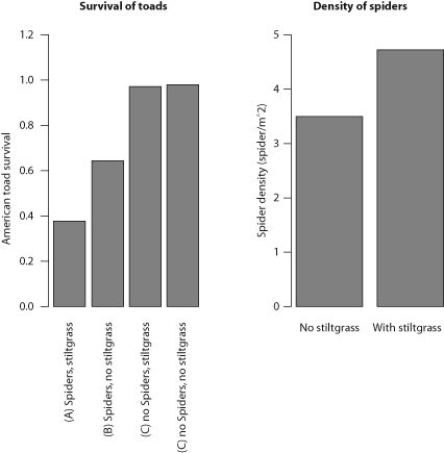Japanese stiltgrass is an invasive plant that was accidentally introduced to the United States in the early 1900s. It can be found on roadsides and in forests, and it has many impacts on native plants and animals. Biologists Jayna DeVore and John Maerz studied the effect of Japanese stiltgrass on American toads in their natural habitat. They enclosed American toads in cages with lycosid spiders and/or Japanese stiltgrass. The four treatments were (A) lycosid spiders and Japanese stiltgrass, (B) lycosid spiders without Japanese stiltgrass, (C) lycosid spiders and Japanese stiltgrass, and (D) no lycosid spiders and no Japanese stiltgrass. They compared the survival of American toads across the treatments (left graph) . They also measured the density of lycosid spiders in different areas where Japanese stiltgrass was absent vs. present (right graph) .
 Source: DeVore, J. L., & Maerz, J. C. (2014) . Grass invasion increases top‐down pressure on an amphibian via structurally mediated effects on an intraguild predator. Ecology, 95(7) , 1724-1730.
Source: DeVore, J. L., & Maerz, J. C. (2014) . Grass invasion increases top‐down pressure on an amphibian via structurally mediated effects on an intraguild predator. Ecology, 95(7) , 1724-1730.
-American toads consume insects. An American toad that is consuming herbivorous insects is considered a
A) secondary consumer.
B) primary consumer.
C) primary producer.
D) tertiary consumer.
Correct Answer:
Verified
Q52: What are the consequences if decomposers are
Q53: In your backyard you overturn a large
Q54: Which list accurately orders a food chain
Q55: Kudzu is a fast-growing vine that was
Q56: Denitrifying bacteria convert _ to _.
A) ammonium;
Q57: The most worrisome results of the large-scale
Q58: Which trophic level in this food chain
Q59: Consider the following marine community: Sea otters
Q60: A stonefly is an aquatic insect that
Q61: Japanese stiltgrass is an invasive plant that
Unlock this Answer For Free Now!
View this answer and more for free by performing one of the following actions

Scan the QR code to install the App and get 2 free unlocks

Unlock quizzes for free by uploading documents